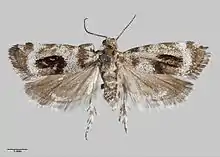| Asterivora inspoliata | |
|---|---|
 | |
| Male holotype specimen held at the Auckland War Memorial Museum. | |
| Scientific classification | |
| Domain: | Eukaryota |
| Kingdom: | Animalia |
| Phylum: | Arthropoda |
| Class: | Insecta |
| Order: | Lepidoptera |
| Family: | Choreutidae |
| Genus: | Asterivora |
| Species: | A. inspoliata |
| Binomial name | |
| Asterivora inspoliata | |
| Synonyms[2] | |
| |
Asterivora inspoliata is a species of moth in the family Choreutidae.[1] It is endemic to New Zealand and has been found in the southern parts of the South Island. Adults are on the wing in December and January.
Taxonomy
.jpg.webp)
This species was first described by Alfred Philpott in 1930, using a specimen collected by C. E. Clarke at Flat Mountain, Hunter Mountains in December at 4,000 feet (1,200 m), and named Simaethis inspoliata.[3] In 1939 George Hudson discussed and illustrated this species under that name.[4] In 1979 J. S. Dugdale placed this species within the genus Asterivora.[5] In 1988 Dugdale confirmed this placement.[2] The male holotype specimen, collected at Flat Mountain, is held at the Auckland War Memorial Museum.[2]
Description
.jpg.webp)
Philpott described this species as follows:
♂. 10 mm. Head and thorax dark brown. Pace grey. Palpi, second segment with dense rounded descending tuft, grey. Antennae black spotted with white, ciliations in ♂ 3+1⁄4. Abdomen greyish fuscous. Legs dark fuscous, mixed and banded with white. Porewings with costa slightly arched, apex rounded, termen almost straight, oblique; brown; markings formed chiefly by dense white irroration; a small irregular basal patch; a broad band from 1⁄5 to 1⁄2 costa and 1⁄4 to 1⁄2 dorsum, its inner edge slightly incurved and its outer margin irregular; a broad fascia from costa at 3⁄4 to tornus, constricted beneath costa and somewhat excurved; a thin subterminal line white on costa and metallic blue round termen: between second and third fasciae on lower half of wing a large black blotch enclosing two small patches of metallic blue scales: fringes brown, touched with white at tornus and with a darker basal line. Hindwings pale purplish brown, lighter towards apex; a rather obscure white fascia from tornus reaching about half way round termen and keeping close to the margin: fringes brown, more or less white-tipped and with a darker basal line.[3]
Distribution
This species is endemic to New Zealand and has been found in subalpine habitat in the hills and mountains of Otago, Fiordland and Southland.[2][6]
Behaviour
Adults of this species are on the wing in December and January.[3][6]
References
- 1 2 Gordon, Dennis P., ed. (2010). New Zealand inventory of biodiversity: Kingdom animalia: chaetognatha, ecdysozoa, ichnofossils. Vol. 2. p. 457. ISBN 978-1-877257-93-3. OCLC 973607714. OL 25288394M. Wikidata Q45922947.
- 1 2 3 4 John Stewart Dugdale (23 September 1988). "Lepidoptera - annotated catalogue, and keys to family-group taxa". Fauna of New Zealand. Department of Scientific and Industrial Research. 14: 113. doi:10.7931/J2/FNZ.14. ISSN 0111-5383. Wikidata Q45083134.
- 1 2 3 Philpott, Alfred (1930). "New Species of Lepidoptera in the Collection of the Auckland Museum". Records of the Auckland Institute and Museum. 1: 12. ISSN 0067-0464. JSTOR 42905932. Wikidata Q58676529.
- ↑ George Vernon Hudson (1939), A supplement to the butterflies and moths of New Zealand, Illustrator: George Hudson, Wellington: Ferguson and Osborn Limited, p. 457, OCLC 9742724, Wikidata Q109420935
- ↑ J. S. Dugdale (July 1979). "A new generic name for the New Zealand species previously assigned to Simaethis auctorum (Lepidoptera: Choreutidae), with description of a new species". New Zealand Journal of Zoology. 6 (3): 461–466. doi:10.1080/03014223.1979.10428386. ISSN 0301-4223. Wikidata Q54576372.
- 1 2 "Asterivora inspoliata Philpott, 1930". www.gbif.org. Retrieved 2022-02-04.